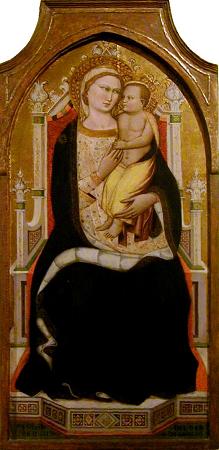Lorenzo di Bicci (c1350 - c1420). Lorenzo di Bicci was an Italian painter of the Florentine School considered to be one of the most important painters in Florence during the second half of the 14th century. He is believed to have learned his trade from his father, about whom little is known. Lorenzo's style, as well as that of his contemporaries Jacopo di Cione and Niccol˛ di Pietro Gerini, was influenced by the artist Andrea di Cione. Lorenzo's paintings made use of bright colors and his compositions avoided complexity. The figures he painted tended to have round faces and were often expressionless. Another one of Lorenzo's distinctive characteristics was his precision of execution. He was known for exceptional talent in drawing, an ability that he put to use at the initial stages of his painting. Unlike many celebrated Florentine artists of this period, Lorenzo mostly received commissions from the country clergy and from the lower-middle class Florentine guilds. His successors, Bicci di Lorenzo and Neri di Bicci, continued to serve these groups. Lorenzo di Bicci was born in Florence around 1350. He is thought to have been taught the art of painting by his father, who most likely went by the nickname Jacopo, although his full name is currently unknown. By 1370, Lorenzo had become a member of the Guild of Saint Luke, the painters' guild of Florence. The guild was named in honor of Luke the Evangelist, the patron saint of artists, whom John of Damascus had recognized as having painted the Virgin Mary's portrait. The Guild of Saint Luke brought together artists from a range of disciplines in Renaissance Florence. Lorenzo's earliest work suggests the influence of a master whose identity is unknown but who was believed to be a member of the Guild of Saint Luke. Lorenzo's first public work was a panel depicting St. Martin Enthroned, painted for the Arte dei Vinattieri, the wine-merchants' guild of Florence. The painting was mounted in the Florentine church of Orsanmichele on a pilaster assigned to the guild on October 4, 1380, and is now in the Depositi Galleria d'Arte in Florence. The predella depicts the episode of St. Martin dividing his cloak with the beggar. It was about this time that Lorenzo began working with the painters Agnolo Gaddi, Corso di Jacopo, and Jacopo di Luca, and the goldsmiths Piero del Miglior and Niccolo del Lucia. As a group they were commissioned to value the statues of Faith and Hope by Giacomo di Pero created for the spandrels of the Loggia della Signoria in Florence. Lorenzo was commissioned to apply the blue enamelled ground and to gild the statues, work that provided him a steady income. A more significant project arrived In 1387 when Lorenzo was employed to decorate the cathedral of Florence. This was a major project already underway at the time. Together with Spinello Aretino and Agnolo Gaddi, Lorenzo produced preliminary drawings for the statues of the four Apostles which would be executed in marble for the fašade of the church. Once the series of statues was completed, he was then commissioned, again with Aretino and Gaddi, to paint and gild them. In his biography of the artist, Giorgio Vasari notes that Lorenzo learned much of his craft from Spinello, probably during this time. Although Giorgio Vasari's biography of Lorenzo is replete with misattributions, it does suggest that Lorenzo, during this period, produced frescoes both in and out of the city of Florence. Vasari suggests that Giovanni di Bicci de' Medici commissioned Lorenzo to paint the hall of the old house of the Medici family. Among other works that Vasari mentions are a shrine on the bridge of Scandicci and a fresco of saints together with a Madonna at Cerbaia. According to Vasari, Lorenzo was then commissioned by the family of the Medici to paint a chapel in San Marco in Florence, a fresco in which he illustrated many stories of the Madonna and depicted the Virgin herself surrounded by many saints. In 1394 Lorenzo returned to the Loggia della Signoria where he painted and gilded the statue of Charity by Jacopo di Piero Guidi. In 1395, he was commissioned to value a statue of St. Victor by Piero di Giovanni Tedesco for the facade of the Florence cathedral. Three years later, in Florence, Lorenzo created three polylobed panels for the altar of the Madonna delle Grazie in the cathedral's nave. The panels displayed half-length images of St John the Evangelist, St. Matthew, and St. Mark. Another artist, Pesello, was responsible for the image of the Agnus Dei, which centered the canopy's vault, while Lorenzo's most significant contribution was a curtain that accompanied the image of the Virgin. This canopy has since been dismantled and Lorenzo's panels depicting the Evangelists are now housed in the Sagrestia dei Canonici in the cathedral.
more...









